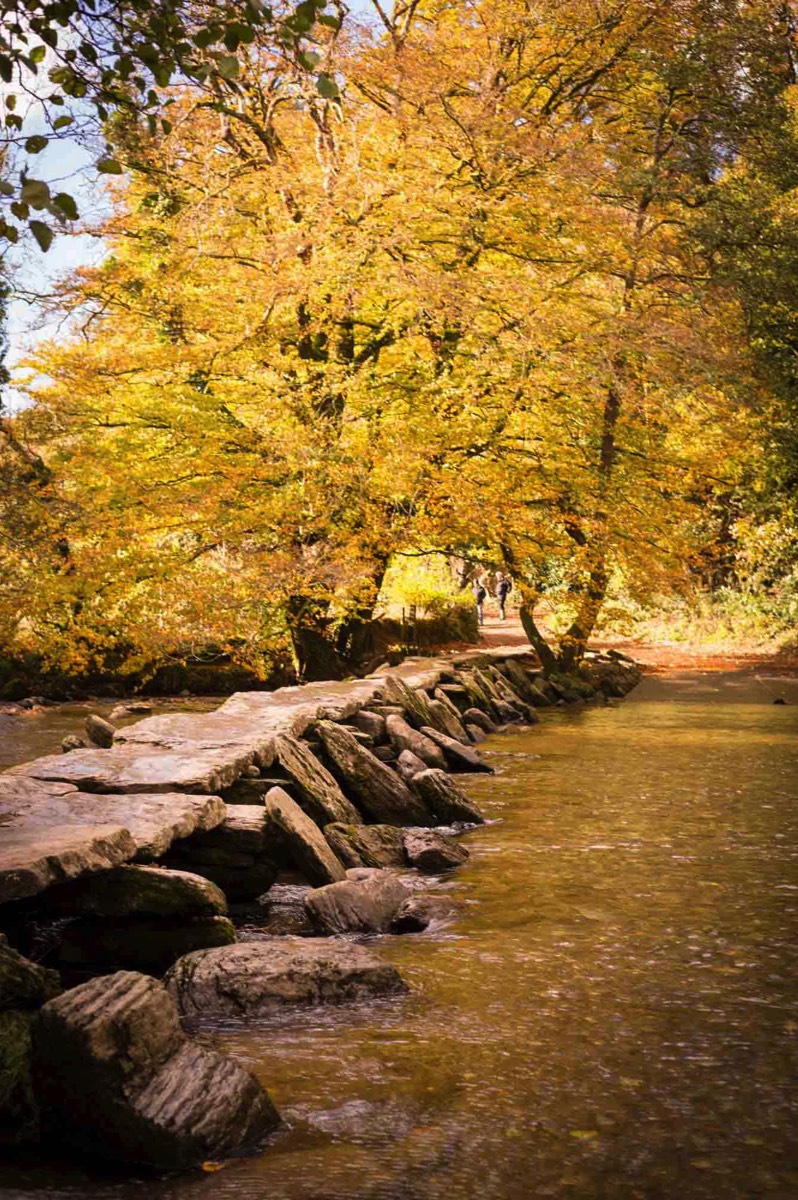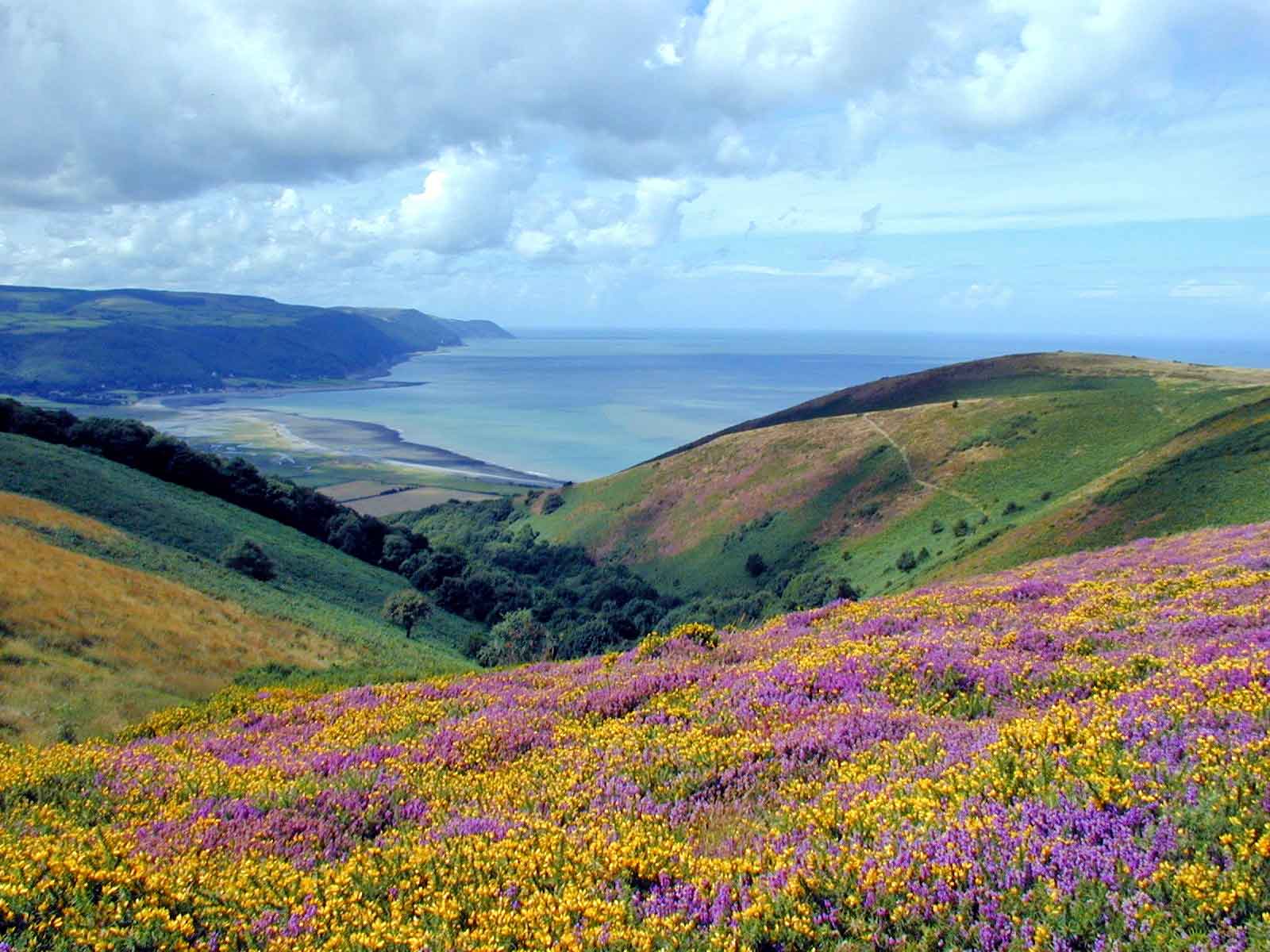TRAVEL
Surrey’s Premier Lifestyle Magazine
Lorna Doone is 150
Richard Doddridge Blackmore’s classic novel Lorna Doone: A Romance of Exmoor weaves veins of fact and fiction together, but the location and landscape are the same. In the book’s 150th anniversary year, Kevin Pilley travels to the novel’s setting in Exmoor, along the north Somerset/Devon border, sorting fact from fiction.
“The loss of so much native sense and eloquence makes one think that innkeepers should be made to keep careful notebooks so that at some later date when the nimblest and most vivid talkers have long been silent, posterity may learn how they regarded things.”Before deciding upon the world’s largest crab sandwich, ask for some local history at the fourteenth-century harbourside The Rising Sun Hotel at Lynmouth on the famous literary north Somerset and Devon coastline. Then, having digested the history and half the sandwich, raise a toast to the landlord and R.D. Blackmore. The Sun may be the birthplace of west country literary tourism.
The 180-mile Tarka Trail, centred around Barnstaple, celebrates the voyages of Henry Williamson’s otter in the book published in 1957. The 51-mile Coleridge Way is a footpath linking sites associated with the poet – including his Nether Stowey cottage. The Trail also commemorates Wordsworth, Shelley and Southey. But the Way only opened in 2005.
The area became popular when the Napoleonic War made the Grand Tour impossible. Thomas Gainsborough honeymooned in the Victorian resort of Lynmouth, famous for its water-powered 1890 Cliff Railway. Margaret Drabble’s The Witch of Exmoor came out in 1998.
But long before, despite its remoteness, people were visiting Exmoor, Britain’s highest clifftops (Great Hangman near Combe Martin) and longest woodland coastline, to follow in the footsteps of a fictional but definitely hapless maiden who didn’t have the best of wedding days.
The 180-mile Tarka Trail, centred around Barnstaple, celebrates the voyages of Henry Williamson’s otter in the book published in 1957. The 51-mile Coleridge Way is a footpath linking sites associated with the poet – including his Nether Stowey cottage. The Trail also commemorates Wordsworth, Shelley and Southey. But the Way only opened in 2005.
The area became popular when the Napoleonic War made the Grand Tour impossible. Thomas Gainsborough honeymooned in the Victorian resort of Lynmouth, famous for its water-powered 1890 Cliff Railway. Margaret Drabble’s The Witch of Exmoor came out in 1998.
But long before, despite its remoteness, people were visiting Exmoor, Britain’s highest clifftops (Great Hangman near Combe Martin) and longest woodland coastline, to follow in the footsteps of a fictional but definitely hapless maiden who didn’t have the best of wedding days.

Tarr Steps clapper bridge over the River Barle Photo copyright: Conor Purcell
Although it only sold 300 out of the initial 500 limited run, Lorna Doone: A Romance of Exmoor sold out on its second, one-volume publication. It’s never been out of print since, spawning films and TV adaptations, and is still bringing people to ‘Blackmore Country’. Indeed, Blackmore was one of the most widely read writers of his day. Blackmore’s classic revenge romance is celebrating its 150th anniversary this year. He may have written parts in The Rising Sun.
A qualified lawyer, schoolteacher and son of a curate, Oxfordshire-born Blackmore (1852–1900) lived and holidayed in the west country. Educated at Blundell’s School, Tiverton, his family lived at Bumsley, Parracombe and King’s Nympton. He is buried in Teddington, Middlesex where he became a renowned fruit grower.
Blackmore wrote many books and believed his third book’s success was due solely to the marriage of Queen Victoria’s daughter, Louise, to the Marquis of Lorne, the eldest son of the Duke of Argyll. The book had many fans, including Australian outlaw Ned Kelly. At the time, Blackmore refused to talk about the book, being more interested in his fruit.
Now, two vets lead Lorna Doone literary heritage walking tours.
Jennie Wild met husband Malcolm at the London Veterinary School. They have been married thirty-one years and read Lorne Doone three times between them. “A walking safari in Zambia inspired us to set up our walking holiday business as we love the quiet solitude of walking in a small group. We first came to Exmoor as a weekend escape, but soon found ourselves plotting ways of making the moor our home.”
The Wilds now live in a four-acre smallholding in a traditional Somerset longhouse near Exford in the middle of Exmoor National Park.
Wild about Exmoor offers Dark Sky Reserve star-gazing safaris, deer watches, nightjar treks and guided walks to miniliths, standing stones, over pack bridges and fords, as well as the Doone literary trail around Malmesmead and Badgworthy Water. The ruins of Lorna’s Cott in the Doone Valley at Hoccombe Combe is seven miles from Lynton. The gibbet posts may have gone, but the chines (crests), puckseys (bogs) and dun and bay ponies all remain. As does the Tarr Steps clapper bridge over the River Barle, Robber’s Bridge, Dunster Yarn Market (1609) and Exmoor’s unique fingerposts.
A qualified lawyer, schoolteacher and son of a curate, Oxfordshire-born Blackmore (1852–1900) lived and holidayed in the west country. Educated at Blundell’s School, Tiverton, his family lived at Bumsley, Parracombe and King’s Nympton. He is buried in Teddington, Middlesex where he became a renowned fruit grower.
Blackmore wrote many books and believed his third book’s success was due solely to the marriage of Queen Victoria’s daughter, Louise, to the Marquis of Lorne, the eldest son of the Duke of Argyll. The book had many fans, including Australian outlaw Ned Kelly. At the time, Blackmore refused to talk about the book, being more interested in his fruit.
Now, two vets lead Lorna Doone literary heritage walking tours.
Jennie Wild met husband Malcolm at the London Veterinary School. They have been married thirty-one years and read Lorne Doone three times between them. “A walking safari in Zambia inspired us to set up our walking holiday business as we love the quiet solitude of walking in a small group. We first came to Exmoor as a weekend escape, but soon found ourselves plotting ways of making the moor our home.”
The Wilds now live in a four-acre smallholding in a traditional Somerset longhouse near Exford in the middle of Exmoor National Park.
Wild about Exmoor offers Dark Sky Reserve star-gazing safaris, deer watches, nightjar treks and guided walks to miniliths, standing stones, over pack bridges and fords, as well as the Doone literary trail around Malmesmead and Badgworthy Water. The ruins of Lorna’s Cott in the Doone Valley at Hoccombe Combe is seven miles from Lynton. The gibbet posts may have gone, but the chines (crests), puckseys (bogs) and dun and bay ponies all remain. As does the Tarr Steps clapper bridge over the River Barle, Robber’s Bridge, Dunster Yarn Market (1609) and Exmoor’s unique fingerposts.
Porlock Bay, Exmoor National Park Photo copyright: visit exmoor
“On our tours, we have a picnic at was probably the Doone settlement in the ancient beech woods,” says Jennie. “A mutton pasty is included as mentioned in the book! No cider though. Although much is consumed during the book!”
She continues: “We visit Cloud Farm, the Culm Valley, the Blackmore memorial stone erected on the book’s centenary, the waterslide where John Ridd loach fished and met Lorna and, of course, Oare Church. The shooting of a young man in a church in Chagford, Devon may have inspired the famous scene. Blackmore’s grandfather preached there.”
Adds Malcolm: “The Doone valley marks the boundary of Somerset and Devon. Both counties claim Lorna and Blackmore for their own. Exeter Cathedral has a memorial. The Doones and Ridds definitely existed. As did Faggus the highwayman and Mother Meldrum, a witch, lived at the Valley of the Rocks near Lynton. The book weaves veins of fact and fiction. But the locations and landscape are the same. We still have the enclosed valleys and bleak dreary moors and rills running into rivulets running to brooks.”
Events during 2019 include an exhibition in Dulverton Heritage Centre. Exhibition designer Sue Baker first came to Exmoor to study its ponies for a zoological doctorate. “My favourite location must be Landacre Bridge over the River Barle on Withypool Common where Jeremy Stickles is attacked by the Doones.
“Creating the exhibition has thrown up some unusual challenges, particularly making the figures for the diorama. I never expected buying body parts online! I had to source John Ridd’s body from Carlisle and his head from France! The Cumbrian body was dark grey. I will never forget the face of the owner of our local car body shop when I took the headless John mannequin in for a re-spray!”
In addition, the Exmoor White Horse Inn, a fifteenth century coach inn on the River Exe in Exford, exhibits the work of landlord and renowned local photographer, Peter Hendrie.
The 150th anniversary of Lorna Doone: A Romance of Exmoor is being marked across Exmoor with a series of events throughout the year.
essence info
Websites: www.visit-exmoor.co.uk www.exmoor-whitehorse.co.uk www.wildaboutexmoor.com locandaontheweir.co.uk
She continues: “We visit Cloud Farm, the Culm Valley, the Blackmore memorial stone erected on the book’s centenary, the waterslide where John Ridd loach fished and met Lorna and, of course, Oare Church. The shooting of a young man in a church in Chagford, Devon may have inspired the famous scene. Blackmore’s grandfather preached there.”
Adds Malcolm: “The Doone valley marks the boundary of Somerset and Devon. Both counties claim Lorna and Blackmore for their own. Exeter Cathedral has a memorial. The Doones and Ridds definitely existed. As did Faggus the highwayman and Mother Meldrum, a witch, lived at the Valley of the Rocks near Lynton. The book weaves veins of fact and fiction. But the locations and landscape are the same. We still have the enclosed valleys and bleak dreary moors and rills running into rivulets running to brooks.”
Events during 2019 include an exhibition in Dulverton Heritage Centre. Exhibition designer Sue Baker first came to Exmoor to study its ponies for a zoological doctorate. “My favourite location must be Landacre Bridge over the River Barle on Withypool Common where Jeremy Stickles is attacked by the Doones.
“Creating the exhibition has thrown up some unusual challenges, particularly making the figures for the diorama. I never expected buying body parts online! I had to source John Ridd’s body from Carlisle and his head from France! The Cumbrian body was dark grey. I will never forget the face of the owner of our local car body shop when I took the headless John mannequin in for a re-spray!”
In addition, the Exmoor White Horse Inn, a fifteenth century coach inn on the River Exe in Exford, exhibits the work of landlord and renowned local photographer, Peter Hendrie.
The 150th anniversary of Lorna Doone: A Romance of Exmoor is being marked across Exmoor with a series of events throughout the year.
essence info
Websites: www.visit-exmoor.co.uk www.exmoor-whitehorse.co.uk www.wildaboutexmoor.com locandaontheweir.co.uk


